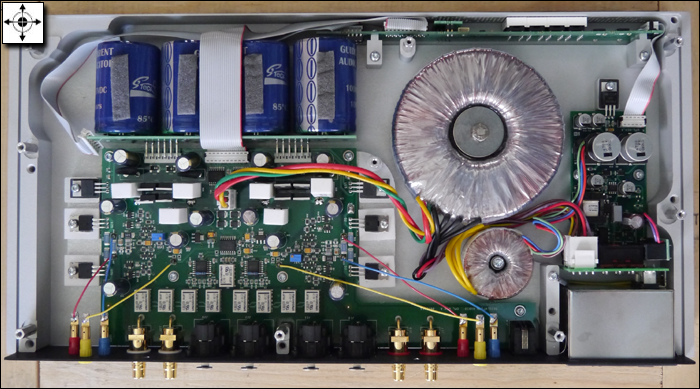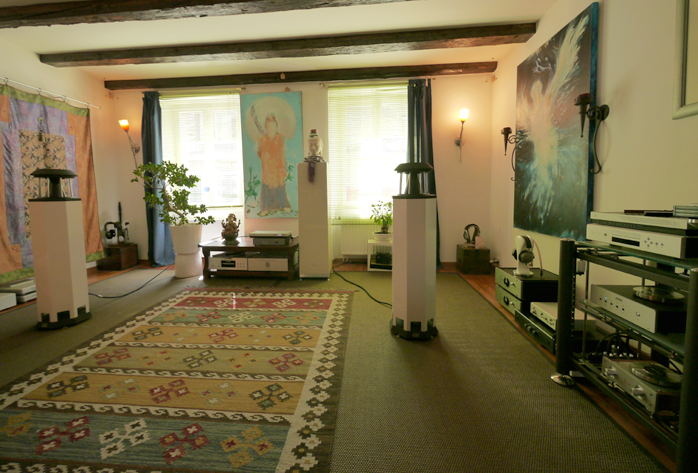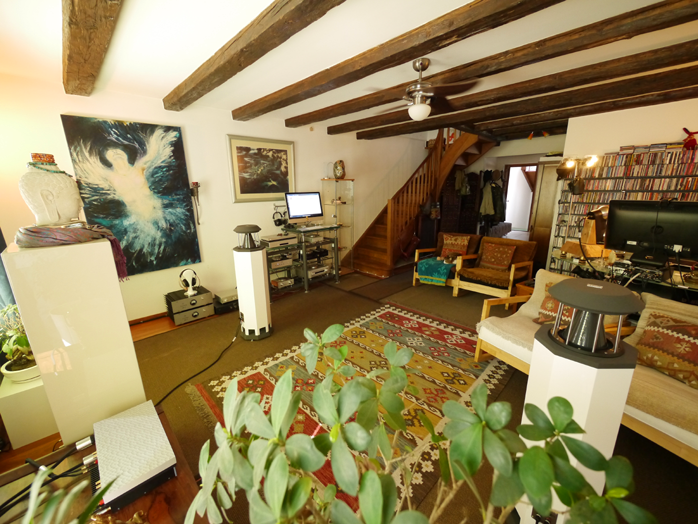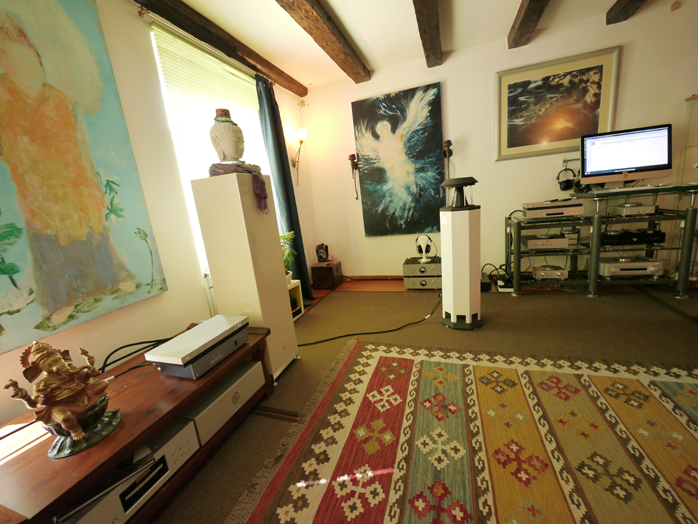This review page is supported in part by the sponsors whose ad banners are displayed below |
 |
 |
When Reson's René Reuter saw my tell-all preview shot of the C50 amp, he apologized. "When we returned from Munich, our shop was in a bit of a state. We had the right amp ready for shipping but an employee made a mistake and shipped the wrong one. Looking at the photo I knew something wasn't right. The current version had a few updates." I duly popped its bonnet for the obligatory follow-up of what current customers would buy.
|
 |
René had more news when he confirmed shipment of the replacement amp. "Jeff just sent me the first non-beta UPnP firmware for the Cantata Music Center. We put the disc in the accessory box of the crate in case you're interested and have time left to give it a try. 2.10 is the first firmware which adds UPnP streaming client functionality. 2.07 is the current release in case you would like to go back. For the upgrade just insert the disc and wait until the player goes to standby.
Otherwise you can find firmware and Windows drivers here. For UPnP mode 192kHz Flac is currently just okay i.e. on the edge. Jeff is already working on improving that for version 2.11." Two weeks later there were more news. "Jeff has worked hard on the speed improvement. So 192k FLAC is now working flawlessly on UPnP."
|
 |
I swapped out the amp in our upstairs small 2-channel music/video system and packed up the first to complete the burn-in process.
|
|
|
After reviewing the $1.495 Goldmund Job 225 amp, I'd held on to it "to keep future amps honest". This direct-sold small plain box is essentially a $6.470 Goldmund Metis Three stereo amp with a mono power toroid. It's thus got the very same 30 years of circuit refinements and 9 generations of R&D teams behind it which have chased down Swiss obsession with the elimination of time distortion in all their amps. Because the 225 has no volume control, I preceded it and the Resolution with Khozmo's remote-controlled passive. The Cantata integrated of course had the passive bypassed to set its own volume. The single Khozmo series resistor which this left in its path was the tiny price to pay for quicker amp switching. Speakers were my new German Physiks HRS-120 omnis. At 87dB paper efficiency with a very practical ~3dB of extra room gain from true 360° radiation across its entire bandwidth, as a load this bending-wave widebander with downfiring 10" sealed woofer taking over at 240Hz was well within the purview of the Cantata amp.
|
 |
German Physiks HRS-120 with C50 and Job 225 preceded by Metrum Hex DAC and Khozmo passive
|
 |
On raw gain and with classical fare recorded at its usual lower median levels to account for higher dynamic range however—say Fabio di Càsola's brilliant reading of Weber's Clarinet Concertos and Quintet on Sony Music with the Russian Chamber Philharmonic of St. Petersburg—my Metrum Hex's 2V RCA output maxed out on the dot. Signal strength was just right but no more. 'twas 100 out of 100 on the C50. Hence there's good reason for the boffo 5.5Vrms the partnering deck's XLRs deliver (the Hex does 4V balanced). With popular music like Volkan Konak's Lifor meanwhile and still on the Hex's RCA I was down to 82 on the display for the same at-ear volume, i.e. with plenty of headroom. |
|
| Key distinction in favor of the Swiss was what Germans call Strahlungskraft. Verbatim that'd be radiation force. For our purposes it's probably best translated as penetrating brilliance. And the DC-coupled high bandwidth Job 225 had more. This higher pressurized shining didn't render the American pale or washed out by contrast. It simply sounded mellower, more laid back and politer instead. It generated less through-the-room projection from the virtual stage which was set back deep behind the speakers. Tone colors were similarly developed as the Swiss amp. Tones had firm centers rather than seem hollow as though color had been merely applied to their surfaces. |
|
|
| |
|
 |
This ability to portray cored tone is essential for any clarinet recording. Otherwise the instrument can sound watery or a tad glassy. With di Càsola playing the warmer Böhm rather than Öhler bore, that was even more relevant. What the litte American amp lacked by comparison wasn't timbre saturation but incisiveness. As an omni speaker the HRS-120 deliberately activates far more ambient reflections than direct radiators do. This relies on amp 'speed' lest it turn indistinct and overly suffused by decays. I'd already taken the pulse with my 5-driver 3-way AudioSolutions Rhapsody 200 towers with their underdamped twin ports. I ultimately found the C50's smaller-fisted grip better suited to the simpler sealed German Physiks. That made them the key players. |
|
|
 |
C50 and Norma IPA-140 with AudioSolutions Rhapsody 200
|
To eliminate the Metrum/Khozmo front end as a possible dilution, I swapped in the Cantata DAC. Its variable single-ended outputs drove both Job 225 and C50 directly for even footing. This indeed did diminish the difference in Strahlungskraft. Perhaps the passive had not properly driven the C50's input stage whilst the Job 225 was less critical. The remaining otherness between amps now was primarily that of attack vigor. Easily heard on electric guitar volleys and snotty Balkan brass salvos, the Job 225 had more aggressivity. Think of it as appropriate stridency. Odd-order overdrive harmonics and crackling trumpets not blown pretty ought to have it. Here the C50 was somewhat more civilized.
On coin appeal the Khozmo/Job 'integrated' would set you back $2.150, about half the Resolution's tariff. The latter is supported by a dealer network. Both former pieces eliminate the middlemen. So on money this was exactly on the money. On performance the biggest decider should be power. Here the Goldmund has thrice as much.
On going up against my budget benchmark amp, the C50 acquitted itself very well (and clearly better than the warmer fuzzier Norma powerhouse). Despite my very effective Vibex powerline DC filter, Resolution's transformer was simply mechanically noisy. I couldn't hear that in the seat but for performance hifi gear such noise always bothers me on principle.
|
|
|
|
| With the Cantatas I kept returning to a very sophisticated handling of tone.
For musicians tone is it. It's what separates them from others. Within bars you ought to know who plays because of it. Clarinet tone relies on embouchure, reed quality, reed thickness, body quality, body bore, mouth piece facing and tip opening size. Listeners needn't know the how but they most certainly are keen to the what. Besides phrasing and fingering skills, tone is a player's personality. Amongst the many delivery qualities it's arguably first. Consider the effort musicians spend on developing beautifully expressive tone. It's disappointing how much hifi narrows and waters down those efforts. |
|
|
|
 |
This isn't about faux tone from circuit voicing. That paints everything with the same patina like a color-shifted filter. What must come forward instead is recorded tone. Here we simply weren't privy to the studio and mixing session. We possess no direct knowledge of the original. All we can do is infer based on the scope of difference between recordings. The more unique recordings sound one from the other, the less meddling our hifi commits. Yet with how poor many recordings are, it's easy to see the dichotomy between starting out with poor ingredients; and wishing for the tastiest of meals. Many listeners thus gravitate towards systems which like a good chef present their meals in the most appealing fashion.
|
 |
|
 |
The collaborators of Kalt and Morecroft struck me as gifted chefs though not of the chemistry-heavy molecular cuisine which might radically alter the self taste of things. Their focus was on enhancing flavor through depth and finesse. It's interesting how this was pulled off without getting rotund or puffed up like basic valve circuits might. Whilst measured it probably would show up as a quite low-dose mix of more 2nd than 3rd-order THD remnants, it doesn't carry the penalty of a heavy patina. It's far milder but nonetheless very attractive. This could surprise valve aficionados. It's not just their output devices which can 'do' tone. And it's this very color expressiveness I heard as the dominant feature of the Resolution Audio sound. |
|
|
 |
|
| From experience reviews of audio gear do best when they focus on just one or two sonic key features. Those must be strong enough to migrate from system to system. Now they're predictable and useful. Minuscule doesn't translate. A mere cable swap upsets minuscule. Then what you hear differs much from what a review promised. This color intensity however shouldn't get lost in translation. When I swapped in the Metrum and Norma DACs, it stayed solidly put. I thus think of that feature as the unique selling proposition of the Resolution Audio Cantata integrated amplifier. Its only failure on the audiophile impressiveness meter? Insufficient power—it's not a macho amp—and living inside too attractive and small a casing when audiophiles still believe that stylish design and serious performance can't coexist. That's the dumb blonde disease. It isn't a joke but sad and sadly persistent. |
|
|
|
 |
  |
 |